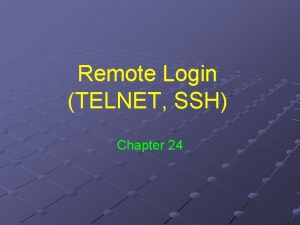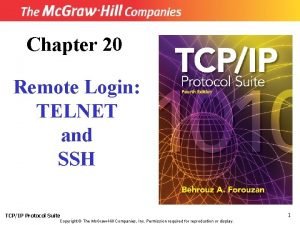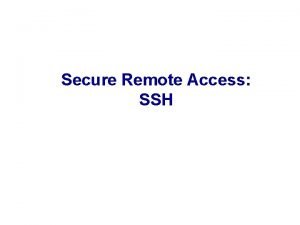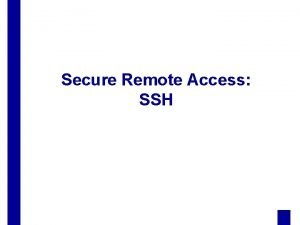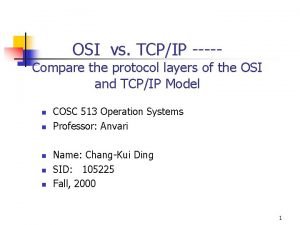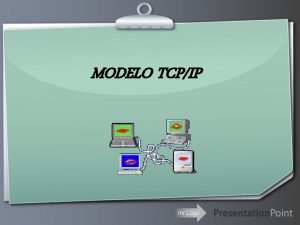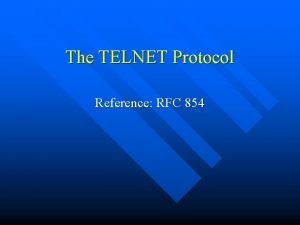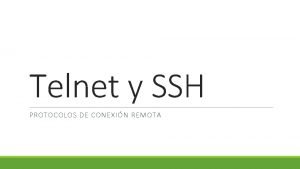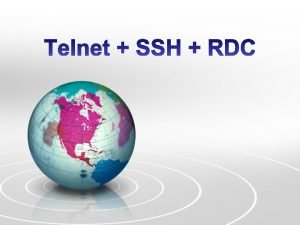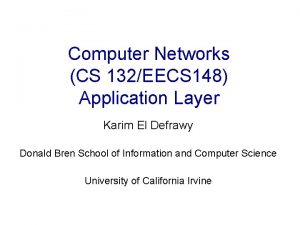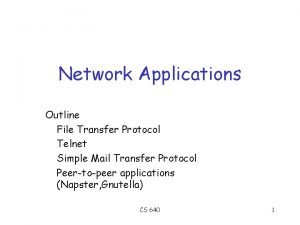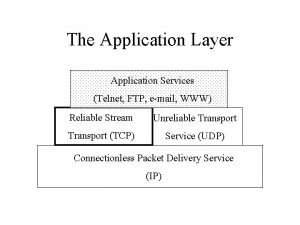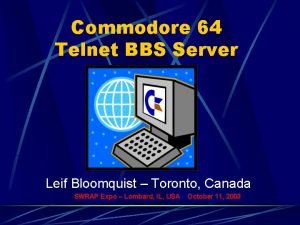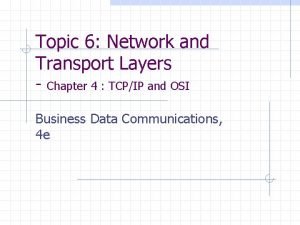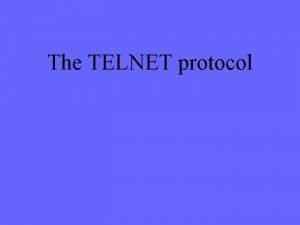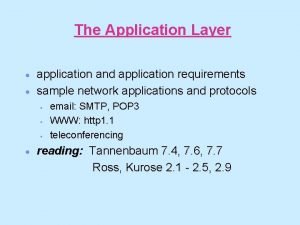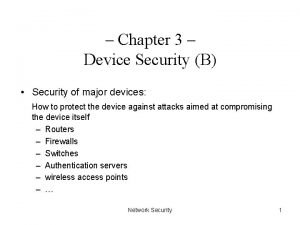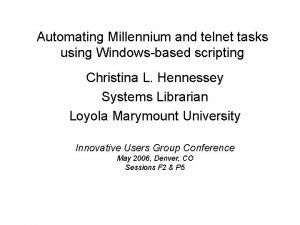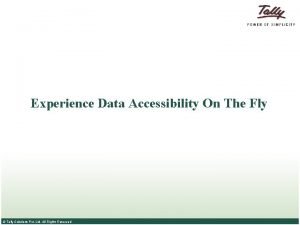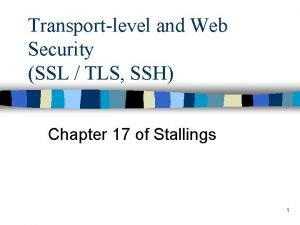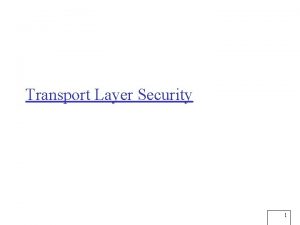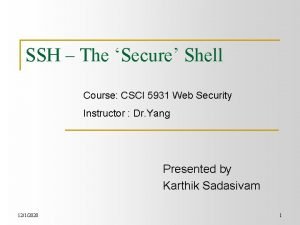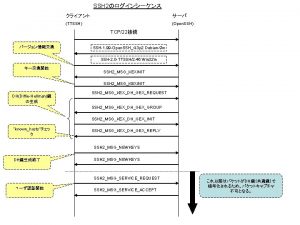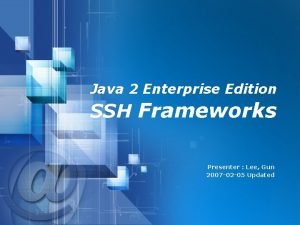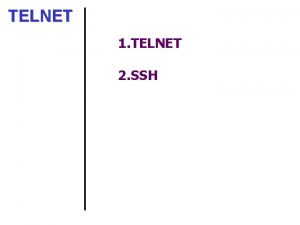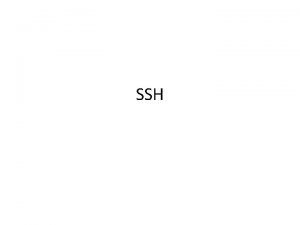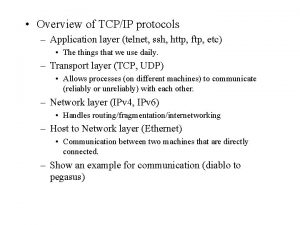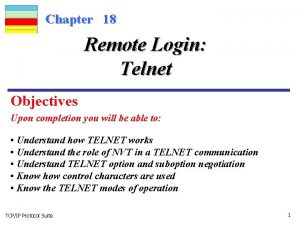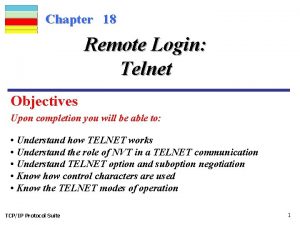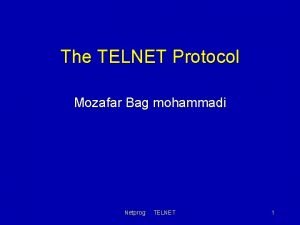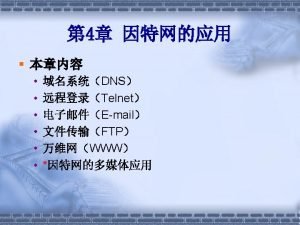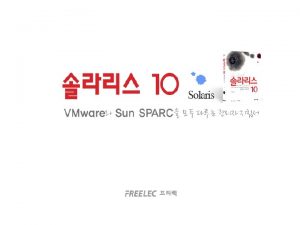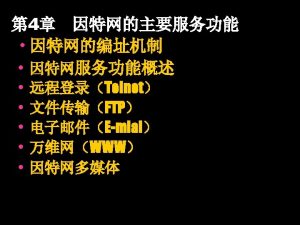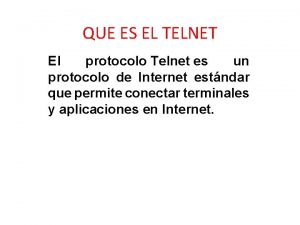Chapter 20 Remote Login TELNET and SSH TCPIP




































- Slides: 36

Chapter 20 Remote Login: TELNET and SSH TCP/IP Protocol Suite Copyright © The Mc. Graw-Hill Companies, Inc. Permission required for reproduction or display. 1

OBJECTIVES: q To introduce the TELNET protocol and show it implements local and remote login. q To discuss options and sub-options used in TELNET and how they are negotiated. q To define out-of-band signaling in TELNET. q To define different modes of operations in TELNET. q To introduce SSH as an alternative to TELNET. q To show different components of SSH are combined to provide a secure connection over an insecure TCP connection. q To discuss port-forwarding in SSH and how it can be used to provide security for other applications. TCP/IP Protocol Suite 2

Chapter Outline TCP/IP Protocol Suite 20. 1 TELNET 20. 2 Secure Shell (SSH) 3

20 -1 TELNET is an abbreviation for TErmina. L NETwork. It is the standard TCP/IP protocol for virtual terminal service as proposed by ISO. TELNET enables the establishment of a connection to a remote system in such a way that the local terminal appears to be a terminal at the remote system. TCP/IP Protocol Suite 4

Topics Discussed in the Section ü Concepts ü Time-Sharing Environment ü Network Virtual Terminal (NVT) ü Embedding ü Options and Suboption Negotiation ü Controlling the Server ü Out-of-Band Signaling ü Escape Character ü Modes of Operation ü User Interface ü Security Issue TCP/IP Protocol Suite 5

Note TELNET is a general-purpose client-server application program. TCP/IP Protocol Suite 6

Figure 20. 1 TCP/IP Protocol Suite Local login 7

Figure 20. 2 TCP/IP Protocol Suite Remote login 8

Figure 20. 3 TCP/IP Protocol Suite Concept of NVT 9

Figure 20. 4 TCP/IP Protocol Suite Format of data and control characters 10

TCP/IP Protocol Suite 11

Figure 20. 5 TCP/IP Protocol Suite An example of embedding 12

TCP/IP Protocol Suite 13

TCP/IP Protocol Suite 14

Figure 20. 6 TCP/IP Protocol Suite Offer to enable an option 15

Figure 20. 7 TCP/IP Protocol Suite Request to enable an option 16

Figure 20. 8 TCP/IP Protocol Suite Offer to disable an option 17

Figure 20. 9 TCP/IP Protocol Suite Request to disable an option 18

Example 20. 1 Figure 20. 10 shows an example of option negotiation. In this example, the client wants the serverto echo each character sent to the server. In other words, when a character is typed at the user keyboard terminal, it goes to the server and is sent back to the screen of the user before being processed. The echo option is enabled by the server because it is the server that sends the characters back to the user terminal. Therefore, the client should request from the server the enabling of the option using DO. The request consists of three characters: IAC, DO, and ECHO. The server accepts the request and enables the option. It informs the client by sending the three-character approval: IAC, WILL, and ECHO. TCP/IP Protocol Suite 19

Figure 20. 10 TCP/IP Protocol Suite Example 20. 1: Echo option 20

TCP/IP Protocol Suite 21

Figure 20. 11 TCP/IP Protocol Suite Example of sub-option negotiation 22

TCP/IP Protocol Suite 23

Figure 20. 12 TCP/IP Protocol Suite Example of interrupting an application program 24

Figure 20. 13 TCP/IP Protocol Suite Out-of-band signaling 25

Figure 20. 14 TCP/IP Protocol Suite Two different interruptions 26

Example 20. 2 In this example, we use the default mode to show the concept and its deficiencies even though it is almost obsolete today. The client and the server negotiate the terminal type and terminal speed and then the server checks the login and password of the user (see Figure 20. 15). TCP/IP Protocol Suite 27

Figure 20. 15 TCP/IP Protocol Suite Example 20. 2 28

Example 20. 3 In this example, we show the client switches to the character mode. This requires that the client request the server to enable the SUPPRESS GO AHEAD and ECHO options (see Figure 20. 16). TCP/IP Protocol Suite 29

Figure 20. 16 TCP/IP Protocol Suite Example 20. 3 30

TCP/IP Protocol Suite 31

20 -2 SECURE SHELL (SSH) Another popular remote login application program is Secure Shell (SSH). SSH, like TELNET, uses TCP as the underlying transport protocol, but SSH is more secure and provides more services than TELNET. TCP/IP Protocol Suite 32

Topics Discussed in the Section ü Versions ü Components ü Port Forwarding ü Format of the SSH Packet TCP/IP Protocol Suite 33

Figure 20. 17 TCP/IP Protocol Suite Components of SSH 34

Figure 20. 18 TCP/IP Protocol Suite Port forwarding 35

Figure 20. 19 TCP/IP Protocol Suite SSH packet format 36
 Remote login telnet
Remote login telnet Ssh packet format
Ssh packet format Ssh_msg_kexinit
Ssh_msg_kexinit Secure remote login ssh
Secure remote login ssh Osi model history
Osi model history Tcpip
Tcpip Modelo tcpip
Modelo tcpip Osi vs tcp ip
Osi vs tcp ip Protocolo tcpip
Protocolo tcpip Que significa
Que significa Ganesh sittampalam
Ganesh sittampalam Ois 7계층
Ois 7계층 Azure_rm_networkinterface
Azure_rm_networkinterface Rfc 854
Rfc 854 Protocolos telnet
Protocolos telnet Telnet adalah
Telnet adalah Telnet backdoor
Telnet backdoor Telnet sql
Telnet sql Telnet imap
Telnet imap Telnet cis.poly.edu 80
Telnet cis.poly.edu 80 File transfer telnet
File transfer telnet Telnet application layer
Telnet application layer Telnet bbs
Telnet bbs Telnet rlogin
Telnet rlogin Telnet enumeration
Telnet enumeration Ftp, telnet belongs to which layer in edi architecture?
Ftp, telnet belongs to which layer in edi architecture? Telnet protocol
Telnet protocol Telnet gaia.cs.umass.edu 80
Telnet gaia.cs.umass.edu 80 Example of loopback address
Example of loopback address Autoit telnet
Autoit telnet Tally.net remote login
Tally.net remote login Tally remote login
Tally remote login Tls ssh
Tls ssh Ssh protocol stack
Ssh protocol stack Gobbles exploit
Gobbles exploit Tcp22
Tcp22 Ssh lee
Ssh lee
